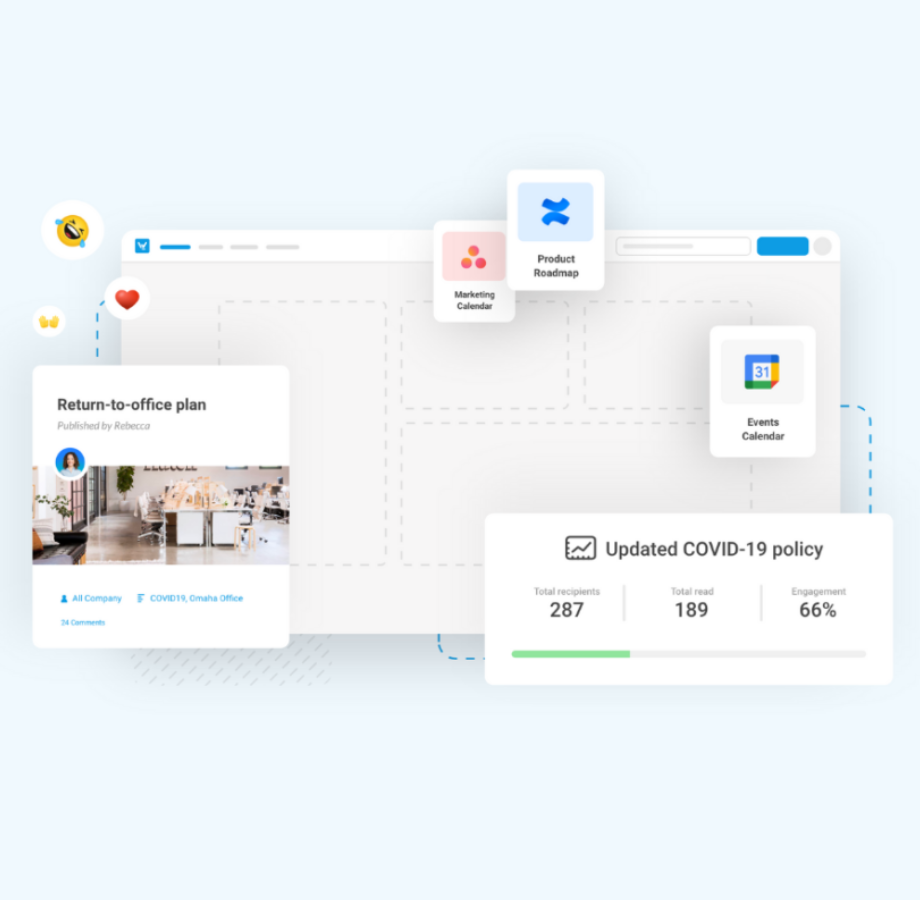The 29 clear benefits of a company intranet

Whether you’re a team of thirty or thirteen thousand, you’ve likely experienced the number one problem with internal communications today: too much information, and never the right stuff. Between all the Slack pings and the email threads and the software notifications, it’s really hard to sift through the noise and know or find the truly important information you need.
That’s one of the major problems that a beautiful, well-structured intranet can solve. Not only that, but the benefits of a company intranet reach far beyond just internal communications: a great central hub can have huge, tangible impacts on your bottom line and your employees’ well-being. (We thought of at least 29 benefits, right off the top of our head.)
Let’s go through ’em!
THE BENEFITS OF A COMPANY INTRANET:
1 | Streamline important internal communication
With an intranet, all of your important internal communications can be housed in a single place. One of the easiest ways to describe it is to imagine this scenario: when you go out on a beautiful, tropical vacation for two weeks, you can fully disconnect…and then just log into the intranet when you get back. In minutes, you’d be quickly up-to-date on important company information (no sifting through Slack or email to get to the good stuff).
Without an intranet, your current forms of internal communication have no sense of information hierarchy; you can’t tell if that email or Slack message is actually important (which is why so many of us resort to URGENT in email subject lines, writing ****ALL CAPS MESSAGES WITH TOO MANY EXCLAMATION POINTS!!!!****, or using the dreaded @channel).
2 | Connect your teams across time zones and locations
Cheers to asynchronous communication! An intranet gives you the ability to communicate and move the company forward without the need for employees to be available at the same time your message is sent. It’s an absolute must-have for anyone with a distributed or remote workforce (and, honestly, is hugely beneficial even when you just have team members on different floors of the same building).
3 | Connect your teams across various tech stacks
The marketing team puts their files in Google Drive, the engineering team puts their roadmap in JIRA, the HR team puts benefits updates in Bamboo, the CEO posts all-company meeting recordings in Slack…it’s no wonder that we can’t find what we’re looking for when our teams are all using their own tech stacks. An intranet can provide that happy medium; you can still link off to all those individual locations, but the intranet becomes the go-to place for those cross-department resources and requests.
4 | Support remote workers and scale company culture
Remote workers can often feel disconnected from the company at large, but a well-utilized intranet can succeed in bringing everyone together and making the remote team feel supported. Senior executives and leaders can use the platform to share the company vision, provide updates on objectives, promote ideas, and share knowledge. Human resources can post benefits updates and new initiatives to keep people engaged. Marketing teams can share new campaign launches.
As a result of these improved internal communications, remote employees will feel much more connected to their place of work and will know what’s going on at the company’s HQ…they won’t have to hear about it “through the grapevine.”
5 | Provide employees with quick access to resources
Every department lead knows that there’s a bunch of quick links that they continually get asked for, no matter where they share them or how organized they might be. The company intranet, when set up well, can provide a place to keep all those resources front-and-center, and cut down on one-off requests to find files or folders.

6 | Share information to the right audience, every time
The best intranet software will give you the ability to segment your employees and easily send your update to the right audience at the right time. You can send announcements to the entire company, or target communications to specific employees on certain teams or in certain locations.
With Workshop, you also get analytics for all of your updates, so you can target your follow-up messages as well and remove any redundant information. If the Chicago office is closed for inclement weather, for example, you can know exactly who has/has not seen your post about it, and directly follow up with the employees who haven’t seen it (rather than sending unnecessary reminders to those who have).
7 | Serve as a source of truth in a crisis or emergency
When big news hits, you need to quickly reach all of your distributed employees on their desktops and on the move. Most intranets should feature notification systems to handle these kinds of communications: for example, SMS or email.
Outside of those push notifications, your company’s intranet can become the go-to place to figure out what’s what. Whether it’s closing the office for inclement weather, a large-scale PR problem, or any urgent notification, your intranet can set the record straight and ensure the entire company has all the information they need.
8 | Break down silos between departments
In medium- to large-sized companies, your departments likely will have very little idea about what’s going on with other departments (or how it affects them). This is especially true for remote teams, who are typically only interacting with their managers or direct peers. Your intranet is the perfect place to feature updates, videos, and resources describing the exciting events happening within each department.
9 | Boost productivity
Increasing productivity in your workplace means two things: reducing costs and improving profit. Sounds great, right? Here’s how your company intranet can help make that happen:
- Reducing the time it takes to search for files, folders, and information
- Streamlining administrative procedures
- Less meetings (and therefore savings on travel, costs, time management)
- Effective communication (emails, messaging)
- Promoting efficient, asynchronous teamwork
10 | Create an internal brand
Like any other content created by your company, your intranet is an incredible place to showcase and scale your company culture. It reinforces your company values to employees, and makes a huge positive impression on new employees.
For example, you might use your intranet to share company news, product launches, promotions, retirements, and even failures and/or lessons learned. By taking the time to explain, you let employees know that you’re holding yourself accountable, owning mistakes, celebrating wins, and walking them along a plan to continuously improve

11 | Add transparency in decision-making
You are a shining example of transparent leadership when you make information readily available to employees – regardless of where they sit on your org chart. Your company intranet can be a hub for that, and you can create a place where decisions are transparently shared (and/or get feedback on those decisions directly from employees). It does absolute wonders to build great trust and deep respect throughout all areas of your business.
12 | Manage important company policies and procedures
How many reminders do you have to send to employees about open enrollment, but they still manage to miss the deadlines?! You can create a single source of truth for benefits updates, and with something like Workshop’s intranet, you can see exactly who has seen or acknowledged that update. It’s a streamlined way to ensure that you’re reaching every employee, especially when it comes to important company policies and procedures!
13 | Craft a narrative during times of change
Communication is the most important part of managing change within an organization, and you need a place where it sits front and center. This is it! The intranet is where your employees can hear from leaders within your organization, and you’re able to definitively make a well-documented statement on any topic that the team might be buzzing about.
Here are a few examples of situations that are incredibly difficult to navigate without an intranet:
- Mergers and acquisitions
- COVID-19
- Layoffs
- Locations opening or closing
- Price increases or plan changes
- Org restructuring
- Senior leadership departures
14 | Improve employee engagement
Employee engagement is a crucial part of a company’s growth. That’s why the best intranet software provides employees with a personalized experience, such as opening their home page with relevant news, updates, and resources. On top of that, employees are often able to generate their own content, participate in surveys, and comment on updates, which are all such key drivers of engagement.
With Workshop, not only does each employee have a personalized home page, but they’re also able to subscribe to news feeds (we call them ‘streams’) that interest them, can comment/react on other posts, and can post their own content (with permissions).
15 | Recognize coworkers and show gratitude
One key benefit of a company intranet is that most (if not all) provide a great vehicle for employee appreciation and recognition. Employees will often interact with new updates and provide positive feedback, welcome new coworkers, or congratulate a team on a great launch.
In many cases, there are built-in features for employee recognition; ours is called “Kudos,” and it’s a great way to recognize and thank a coworker who has gone above and beyond in their role.

16 | Further your DEI initiatives
Your company intranet will be a key part of the communication plan for any large scale internal initiative, especially when it comes to diversity, equity, and inclusion. When your DEI committee has identified its goals or wants to change/create a new policy, the intranet is where they can communicate those changes to the rest of the organization.
A few other ways you can use your intranet to help push DEI efforts forward:
- Add multicultural holiday celebrations to your event calendar
- Share instructions for how to set up an ERG at your company
- Create a ‘stream’ for your DEI efforts and continue to hold the company accountable to monthly/quarterly progress
- Post engagement surveys
17 | Find the right person
A handy employee directory (built into most intranet software) makes it quick and easy for employees to get in touch with each other. Most should be searchable on a number of different criteria (name, title, department, etc.), allowing you to find the person you need even when you don’t know their full name. 🙂
18 | Recruit internally
Your company intranet can create internal opportunities for promotion by sharing current job openings in a place that is easily accessible to all employees.
Not only that, but the employee directory is a helpful place to be able to scan and source internal talent to fill any needed vacancies!

19 | Improve collaboration
Put all the information your team needs right at their fingertips and make it easy for them to collaborate, no matter what location they’re in. Plus, being able to communicate effectively with coworkers improves collaboration.
With Workshop, you can attach resource links directly to your updates; you can even use our Streams for keeping a team updated on the status of a project. 🙂
20 | Gather feedback
Having a company intranet makes it easy for HR (or really, any department) to get feedback. Aside from seeing comments and reactions on updates, HR can use the intranet to run polls or surveys to help collect employee’s opinions. You can also analyze updates from different departments, streams, and comments to get a general sense of the mood and emotions of the team.
21 | Make leaders more visible and accessible
In our opinion, the best and most engaging company intranets include a lot of employee-driven content. This is a great place to make leaders within your organization more visible and accessible; not only should they post updates and share their thoughts, but it’s also a go-to for their basic contact information, too.
Here are a few ways we’ve seen this done really well:
- Have the CEO share a weekly letter with the company
- Have department leaders provide monthly updates on their goals and objectives
- Have a new senior leader introduce themselves (with a video!)
- Give your employee resource groups or internal committees a platform to share their initiatives and gain support
22 | Share best practices
Better internal communication, collaboration, and document storage all makes it so much easier to share with colleagues those practices that work best, which also brings us right back to that overall goal of improving productivity.
23 | Connect everyone to the company’s mission
The most engaged employees are always the ones who understand and identify with their company’s overall purpose and mission. It’s not enough to just throw it on your company’s “About Us” page, or to discuss it during onboarding and then never speak of it again. You can carve out a space on the company intranet that’s focused on sharing information relating to how the company’s mission is being met, which allows everyone to be a part of that purpose-driven work and feel more connected!
24 | Reduce emails and meetings
If you’re sharing non-urgent internal communications, your company intranet is a much better place for it than an email thread. You can post your update, pictures, and videos, and target it to the exact right audience. This also provides a place where your employees can react and comment on the content!
As for meetings: your intranet can be used to communicate statuses for larger projects or document decisions being made, so you don’t necessarily need to have those “check-in” meetings, and can save your calendar time for things that are more urgent!
25 | Give employees a voice
According to Forbes, employees who feel that their voices are heard by management are nearly five times more likely to do their best at work. The intranet is an open place where employees can offer their opinions or feedback in the form of comments/reactions, or reach out to a manager if they’re running into any issues.

26 | Streamline employee onboarding
It’s always incredibly overwhelming to start your first day at a new job and have seventeen different places where you need to log in for information. A great, well-structured company intranet can be an elegant solution to this, giving your new hires a central kickoff point to find common resources, get to know the team, and read through the latest updates from senior leadership.
27 | Answer FAQs (before they’re asked)
Slack messages are impossible to find, emails get buried, and paper forms wind up in random piles. On the other hand, an intranet can serve as a go-to spot for employees to get their questions answered at any time. When employees have access to a resource like this, they won’t interrupt your day with questions as much, and it allows them to get back to their tasks a little faster.
Here are a few key items to consider including in your all-company resources and regular updates:
- Employee handbook
- Policies and procedures
- Time off requests
- HR’s contact information
- Organizational chart
- Event calendar
28 | Store meeting recordings and documentation
Part of the benefit of asynchronous communication is that not everyone needs to be present for the meeting to be able to hear/see it, but that creates a follow-up issue: storage! Those meeting recordings can live happily within the resources of your company intranet, and can be there to reference for employees who were out of office (or if you need to go back to re-watch an announcement).
29 | Reduce IT costs
Your IT department is already navigating a maze of software, systems, and tools. Your intranet doesn’t have to be one of them! The introduction of a successful out-of-the-box intranet can save a ton of time and doesn’t need to be maintained by your IT team. Plus, a great intranet can unify all of those software tools into a single central hub, providing a clear entry point for all of your employees.
——————————————————————————————————————
We can’t sing the praises of an intranet enough, but this list is a great place to start. Let us know if we missed anything in the comments!
And if you’re ready to get your own company intranet, we’ve created a quick guide to help you best select your next intranet software (and get buy-in from all the right people). Check it out!








